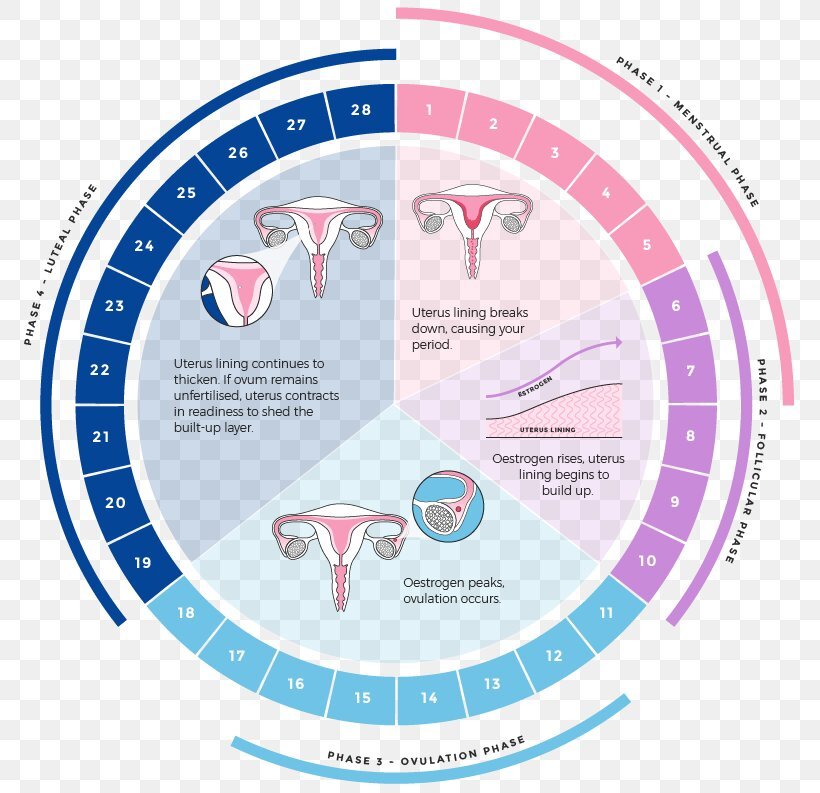Tracking Your Cycle - Are You Wasting Your Time?
By Dannielle Stewart
Tracking your cycle, do you do it?
Isn’t tracking just for trying to get pregnant, or trying to avoid pregnancy, so that you know when you’re most fertile, and thus most likely to become pregnant? Ovulation and your fertile time is just one part of your menstrual cycle, and it’s not the only important one! Your cycle is more than just your period and ovulation. Understanding your menstrual cycle, the four hormonal phases, and the changes to your body and mind in each part of your cycle has numerous benefits! We’re often taught to view periods as only problematic, and for those of us with endometriosis, adenomyosis and PCOS, period pain certainly can be, but your cycle isn’t something inherently bad. It’s more than just that bleed that so many of us have come to dread. If you ask Dr Peta Wright, a gynaecologist and advocate for holistic women’s health, she would tell you that there is magic in your menstrual cycle. In a blog she wrote for QENDO in 2019 (read it here) she says,
“not only does having a normal period (read – not too heavy, not too painful, not MIA) give you vital information about your underlying health and clues about how to fix it, it also means you are making reproductive hormones which are actually so much more important to our health than just baby making. In this way having a period is health giving also”.
Your period can act as a vital sign for your overall health, and it’s one that you’ll benefit from paying attention to. Tracking your cycle, along with the myriad of symptoms, moods, cravings and energy levels that come at different parts of it, can help you better understand your body, plan for potential roadblocks, and utilise bursts of energy. This blog will help give you a basic understanding of the menstrual cycle, using the QENDO app to track your cycle and everything that comes with it, and how you can use this information to your benefit. In the words of period preacher and author of Period Queen, Lucy Peach, “your blood is amazing”.
The Four Phases
The Menstruation Phase
The Follicular Phase
The Ovulation Phase
The Luteal Phase
The menstruation phase, or period, is the beginning of the cycle, day 1. Stretch your mind back to high school biology. Your period occurs when the egg released during ovulation is not fertilised by the male sperm, and the uterine lining that has become rich and thick in preparation for that potential foetus, sheds and exits - the bleed. Next is the follicular phase, though it actually tends to overlap with the first phase, day 5 or 6, and stretching all the way to ovulation. In the follicular phase, your hypothalamus tells the pituitary gland to make follicle-stimulating hormone, or FSH, which - you guessed it - stimulates your ovaries to produce follicles, which contain an egg. The follicular phase is also known as pre-ovulation, it’s often a time of high energy, Lucy Peach advises in her book Period Queen, that this is the “Do” phase, where you climb a metaphorical mountain to ovulation. This is thanks to rising oestrogen, and you may have an increased capacity for energy intensive tasks.
As this follicle matures it causes an increase in oestrogen, which in turn encourages a thickening of the uterine lining - your body getting ready, just in case you happen to become pregnant. Next comes the ovulation phase, where your oestrogen continues to rise, triggering the release of luteinising hormone or LH, which encourages your mature follicle to release the egg which then takes a trip from the ovary, down the fallopian tube and into the uterus. This is the middle of your cycle, typically day 11-14, but everyone’s cycle length varies - hence why learning all about yours is so important. This phase of your cycle is marked by an increase in body temperature, changes in vaginal discharge, as well as an increase in energy and libido. Some people also experience ovulation pain.
The final phase, the Luteal Phase, is typically the longest phase of your cycle. The corpus luteum - basically the shell from which your little egg broke free during ovulation, which seals itself back up again - releases progesterone. If you were to become pregnant, the corpus luteum has a role in maintaining progesterone levels, if no egg has been fertilised the corpus will shrink and cause a decrease in both progesterone and oestrogen, which primes the body to re-enter the menstruation phase, starting your cycle again. The luteal phase is often synonymous with symptoms of PMS - bloating, breast tenderness, cravings, mood swings. This is the phase where we may need to engage in a bit more self care, reserving energy in the phases prior, to avoid a crash from lower energy levels. This self care can last into the menstruation phase, particularly if you do struggle with pain during your cycle.
If you are utilising hormonal contraception, to prevent pregnancy or as a tool to help manage symptoms of endometriosis or adenomyosis, your bleed is not technically a period, it’s a withdrawal bleed from the medication. The bleed is not driven by cyclical hormone changes in the same way as the menstrual phase - there is no ovulation, thus you don’t get the same production of progesterone in the luteal phase that’s stimulated by post-ovulation. Additionally, some menstruators may have anovulatory cycle - a cycle with no luteal phase and progesterone, and a long follicular phase, followed by a breakthrough bleed. This may be caused by PCOS, perimenopause, using some kinds of hormonal birth control, and being a teenager having their first few cycles. Many people have these cycles every so often, and that’s normal. Having ongoing anovulatory cycles, often characterised by cycles that are very short or very long (less than 21 or more than 45 days) or cycles with a prolonged bleed, you may be suffering with PCOS. Always talk to your healthcare team if you’re concerned about any recurring symptoms appearing during your cycle.
Tracking With the QENDO App
If you’ve been as excited for the launch of the QENDO App as we have, you’ll know it’s a chronic illness management tool, a way to track not only your cycle but the symptoms that may occur at any time, and in the absence of a menstrual cycle or even in the absence of a uterus, due to your chronic illness. Not everyone with endometriosis and adenomyosis menstruates, or has a uterus, and that’s the reality for many people in our chronic illness community. But for many affected by endo, adeno, PCOS and infertility, the menstrual cycle remains a central part of their illness and its management, and so we’ve given you the tools within the QENDO App to add a cycle, add bleeding including flow, colour, and characteristics, and track the myriad of symptoms that may occur at different phases of your cycle.
If you’re interested in unlocking some of the “magic of the menstrual cycle”, consider tracking with your phases in mind. For example, knowing that the follicular phase can be a time of increased energy thanks to increasing oestrogen, pay attention to tracking your energy levels - do you experience an increase in energy relative to other parts of your cycle? Do you find yourself tracking longer hours at work or more episodes of study? Are you engaging in more dynamic exercise such as intensive cardio or strength training? You can use the QENDO app to track all these factors and activities, and better understand how your body responds to the changing hormonal phases of your unique cycle. Knowledge is empowering, and you can use it to better prepare each for each cycle as it comes. If you know you get a burst of energy just before ovulation, you can schedule more energy intensive activities to increase your productivity. If you know that your luteal phase brings some of your worst symptoms and potential flare ups of your chronic illness, you can plan work and play around this, prepare self-care and management strategies, and use your toolkit to try and reduce the impact on these symptoms.
Here are some symptoms or activities you may like to pay attention to tracking for each phase of your cycle:
Menstrual Phase
Amount of bleeding
Colour of blood
Consistency of blood
Pain
Cravings
Mood
Energy Levels
Bowel Habits
Exercise
Follicular Phase
Energy Levels
Work
Study
Exercise
Mood
Stress
Discharge
Ovulation Phase
Sex Drive
Discharge
Temperature
Mood
Sex
Work
Exercise
Food
Pain
Luteal Phase
Mood
Cravings
Stress
Anxiety
Depression
Food
Bloating
Bowel Habits
Breast tenderness
Exercise
Headache
Swelling
Tracking and better understanding your cycle also allows you to better communicate your needs to your healthcare team, and identify trends and triggers that you want to improve. Knowing what’s coming can make you feel more in control and better prepared to handle not so good days, with the confidence that you have the toolkit and the team to help you manage.
Remember, you are in control of your health and your body - if something doesn’t feel right, trust your instincts and speak up, seeking a second opinion if you need to. The QENDO community is here for you, all of you, whatever your experience of chronic illness looks like. Happy tracking!
References
Briden, L. Ovulation is the main event of the menstrual cycle. The Period Revolutionary. https://www.larabriden.com/3-signs-your-period-is-not-really-a-period/
Peach, L. Period Queen. Murdoch Books, 2020.
Wright, P. Uncovering the magic of the menstrual cycle. QENDO, 2019. https://www.qendo.org.au/blog/uncovering-the-magic-of-the-menstrual-cycle?rq=The%20magic%20
The materials available on or through the website qendo.org.au [‘QENDO’] are an information source only. Information provided by QENDO does not constitute medical advice and should not be relied upon to diagnose or treat any medical condition.To the maximum extent permitted by law, all contributors of QENDO make no statement, representation, or warranty about the quality, accuracy, context, completeness, availability or suitability for any purpose of, and you should not rely on, any materials available on or through the website qendo.org.au. QENDO disclaims, to the maximum extent permitted by law, all responsibility and all liability (including without limitation, liability in negligence) for all expenses, losses, damages and costs you or any other person might incur for any reason including as a result of the materials available on or through this website being in any way inaccurate, out of context, incomplete, unavailable, not up to date or unsuitable for any purpose.



